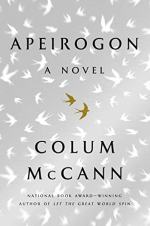|
This section contains 581 words (approx. 2 pages at 400 words per page) |

|
Apeirogon Summary & Study Guide Description
Apeirogon Summary & Study Guide includes comprehensive information and analysis to help you understand the book. This study guide contains the following sections:
This detailed literature summary also contains Quotes and a Free Quiz on Apeirogon by Colum McCann.
The following version of the book was used to create the guide: McCann, Colum. Apeirogon. Random House Publishing Group (Kindle Edition), 2020.
McCann’s novel Apeirogon is written as a dual portrait of two real-life men and their intersecting stories of loss, grief, healing, and reconciliation. Through a mix of present tense narrative, past tense vignettes depicting memories and flashbacks, and copious historical detail for context, the novel follows Bassam Aramin (a Palestinian) and Rami Elhanan (an Israeli) as they reckon with the deaths of their daughters Abir and Smadar and use their experiences to advocate across Palestine, Israel, and the world for peace in the modern Holy Land.
The narrative begins with Rami’s journey on a motorbike from his home in Israeli West Jerusalem into the West Bank—Palestinian territory—while on his way to a monastery for a speaking engagement. Through memories, flashbacks, and explanations, Bassam is introduced, along with the two young girls Abir and Smadar who the reader quickly learns have both been killed by forces relating to the Israeli-Palestinian conflict. Abir was shot in the head by an Israeli soldier with a rubber bullet after buying candy outside her school, and Smadar was killed in a suicide bombing by Palestinian fighters outside a café on a Jerusalem street. Rami, a graphic designer who served in the Israeli military, and Bassam, an archivist who served a lengthy sentence in an Israeli prison, met in a meeting for Bassam’s organization Combatants for Peace and have since solidified their friendship through mutual experiences of loss and through the Parents Circle support group that unites Israeli and Palestinian mothers and fathers who have lost children, as well.
In the myriad vignettes, readers learn more about the history of the Holy Land and of the roots of the modern conflict that wreaks strife across Israel and Palestine today. McCann maintains a largely balanced narrative that gives voice to historical arguments for a Jewish homeland as well as abuses of Palestinian human rights by Israel. In a conflict so polarized and partisan, the perspectives the novel presents—that of an Israeli couple critical of their country’s policies and that of a Palestinian man who studies the Holocaust and publicly calls for peace and reconciliation—inject unique nuance into a literary work at once both informative and deeply emotive.
Other vignettes deal extensively in the emotion and tragedy felt on the days of Abir’s and Smadar’s deaths, Bassam’s year studying in Bradford, England after his daughter has passed, and the lives of the parents of Rami and his wife, Nurit. All are contained within short, past tense chapters that inform and enrich the present-tense narrative, which peaks when Rami and Bassam arrive at the monastery to tell their stories of grief and healing to a small audience and impress upon them the importance of peace and reconciliation. Afterward, the two men leave the monastery and the present tense narrative follows Bassam on his drive back home through Israeli military checkpoints to Jericho in the West Bank, ending with a conversation with his wife, Salwa, and a night tending to his garden under the stars. All the while, the interspersed past tense vignettes continue, now featuring such memories as Salwa and Nurit’s experiences in the aftermath of their daughters’ deaths, Bassam’s hunger strike to end his prison sentence, and his protracted court battle to prosecute the Israeli military for his daughter’s murder.
Read more from the Study Guide
|
This section contains 581 words (approx. 2 pages at 400 words per page) |

|



